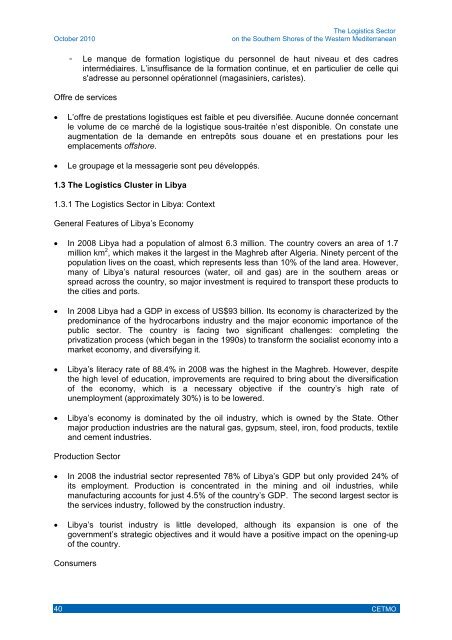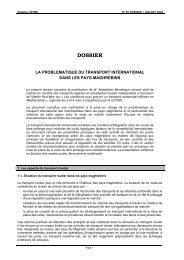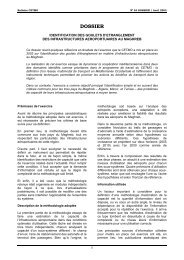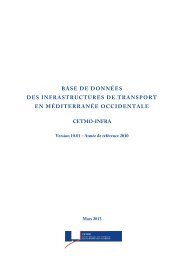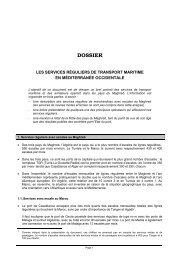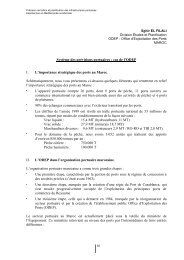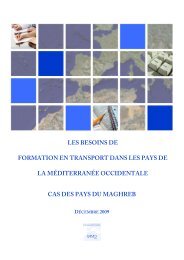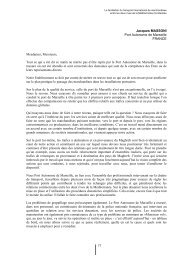The Logistics Sector on the Southern Shores of the Western ... - cetmo
The Logistics Sector on the Southern Shores of the Western ... - cetmo
The Logistics Sector on the Southern Shores of the Western ... - cetmo
- No tags were found...
You also want an ePaper? Increase the reach of your titles
YUMPU automatically turns print PDFs into web optimized ePapers that Google loves.
October 2010<str<strong>on</strong>g>The</str<strong>on</strong>g> <str<strong>on</strong>g>Logistics</str<strong>on</strong>g> <str<strong>on</strong>g>Sector</str<strong>on</strong>g><strong>on</strong> <strong>the</strong> Sou<strong>the</strong>rn <strong>Shores</strong> <strong>of</strong> <strong>the</strong> <strong>Western</strong> Mediterranean◦ Le manque de formati<strong>on</strong> logistique du pers<strong>on</strong>nel de haut niveau et des cadresintermédiaires. L’insuffisance de la formati<strong>on</strong> c<strong>on</strong>tinue, et en particulier de celle quis'adresse au pers<strong>on</strong>nel opérati<strong>on</strong>nel (magasiniers, caristes).Offre de services• L’<strong>of</strong>fre de prestati<strong>on</strong>s logistiques est faible et peu diversifiée. Aucune d<strong>on</strong>née c<strong>on</strong>cernantle volume de ce marché de la logistique sous-traitée n’est disp<strong>on</strong>ible. On c<strong>on</strong>state uneaugmentati<strong>on</strong> de la demande en entrepôts sous douane et en prestati<strong>on</strong>s pour lesemplacements <strong>of</strong>fshore.• Le groupage et la messagerie s<strong>on</strong>t peu développés.1.3 <str<strong>on</strong>g>The</str<strong>on</strong>g> <str<strong>on</strong>g>Logistics</str<strong>on</strong>g> Cluster in Libya1.3.1 <str<strong>on</strong>g>The</str<strong>on</strong>g> <str<strong>on</strong>g>Logistics</str<strong>on</strong>g> <str<strong>on</strong>g>Sector</str<strong>on</strong>g> in Libya: C<strong>on</strong>textGeneral Features <strong>of</strong> Libya’s Ec<strong>on</strong>omy• In 2008 Libya had a populati<strong>on</strong> <strong>of</strong> almost 6.3 milli<strong>on</strong>. <str<strong>on</strong>g>The</str<strong>on</strong>g> country covers an area <strong>of</strong> 1.7milli<strong>on</strong> km 2 , which makes it <strong>the</strong> largest in <strong>the</strong> Maghreb after Algeria. Ninety percent <strong>of</strong> <strong>the</strong>populati<strong>on</strong> lives <strong>on</strong> <strong>the</strong> coast, which represents less than 10% <strong>of</strong> <strong>the</strong> land area. However,many <strong>of</strong> Libya’s natural resources (water, oil and gas) are in <strong>the</strong> sou<strong>the</strong>rn areas orspread across <strong>the</strong> country, so major investment is required to transport <strong>the</strong>se products to<strong>the</strong> cities and ports.• In 2008 Libya had a GDP in excess <strong>of</strong> US$93 billi<strong>on</strong>. Its ec<strong>on</strong>omy is characterized by <strong>the</strong>predominance <strong>of</strong> <strong>the</strong> hydrocarb<strong>on</strong>s industry and <strong>the</strong> major ec<strong>on</strong>omic importance <strong>of</strong> <strong>the</strong>public sector. <str<strong>on</strong>g>The</str<strong>on</strong>g> country is facing two significant challenges: completing <strong>the</strong>privatizati<strong>on</strong> process (which began in <strong>the</strong> 1990s) to transform <strong>the</strong> socialist ec<strong>on</strong>omy into amarket ec<strong>on</strong>omy, and diversifying it.• Libya’s literacy rate <strong>of</strong> 88.4% in 2008 was <strong>the</strong> highest in <strong>the</strong> Maghreb. However, despite<strong>the</strong> high level <strong>of</strong> educati<strong>on</strong>, improvements are required to bring about <strong>the</strong> diversificati<strong>on</strong><strong>of</strong> <strong>the</strong> ec<strong>on</strong>omy, which is a necessary objective if <strong>the</strong> country’s high rate <strong>of</strong>unemployment (approximately 30%) is to be lowered.• Libya’s ec<strong>on</strong>omy is dominated by <strong>the</strong> oil industry, which is owned by <strong>the</strong> State. O<strong>the</strong>rmajor producti<strong>on</strong> industries are <strong>the</strong> natural gas, gypsum, steel, ir<strong>on</strong>, food products, textileand cement industries.Producti<strong>on</strong> <str<strong>on</strong>g>Sector</str<strong>on</strong>g>• In 2008 <strong>the</strong> industrial sector represented 78% <strong>of</strong> Libya’s GDP but <strong>on</strong>ly provided 24% <strong>of</strong>its employment. Producti<strong>on</strong> is c<strong>on</strong>centrated in <strong>the</strong> mining and oil industries, whilemanufacturing accounts for just 4.5% <strong>of</strong> <strong>the</strong> country’s GDP. <str<strong>on</strong>g>The</str<strong>on</strong>g> sec<strong>on</strong>d largest sector is<strong>the</strong> services industry, followed by <strong>the</strong> c<strong>on</strong>structi<strong>on</strong> industry.• Libya’s tourist industry is little developed, although its expansi<strong>on</strong> is <strong>on</strong>e <strong>of</strong> <strong>the</strong>government’s strategic objectives and it would have a positive impact <strong>on</strong> <strong>the</strong> opening-up<strong>of</strong> <strong>the</strong> country.C<strong>on</strong>sumers40 CETMO


